Washingtonia
Washingtonia is a genus of palms, native to the southwestern United States (in southern California, and southwest Arizona, and northwest Mexico (in northern Baja California and Sonora).[2] Both Washingtonia species are commonly cultivated across the Southern United States, the Middle East, southern Europe, and north Africa, where they have greatly hybridized.
| Washingtonia | |
|---|---|
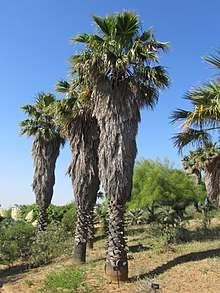 | |
| Scientific classification | |
| Kingdom: | Plantae |
| Clade: | Tracheophytes |
| Clade: | Angiosperms |
| Clade: | Monocots |
| Clade: | Commelinids |
| Order: | Arecales |
| Family: | Arecaceae |
| Subfamily: | Coryphoideae |
| Tribe: | Trachycarpeae |
| Genus: | Washingtonia H. Wendl. 1879,[1] conserved name not Winslow 1854 (syn of Sequoiadendron) |
| Species | |
| Synonyms[2] | |
|
Neowashingtonia Sudw. | |
Description
They are fan palms (subfamily Coryphoideae), with the leaves with a bare petiole terminating in a rounded fan of numerous leaflets. The flowers are in a dense inflorescence, with the fruits maturing into a small blackish-brown drupe 6–10 mm diameter with a thin layer of sweet flesh over the single seed.[3]
Extant species
There are three species: Washingtonia robusta, Washingtonia filifera, and Washingtonia filibusta
| Species | Description | Current distribution |
|---|---|---|
| California washingtonia, northern washingtonia, California fan palm, or desert fan palm Washingtonia filifera (Lindl. ex André) H.Wendl.
|
Tree to 23 m tall; leaves large, with petiole up to 2 m long, and leaflets up to 2 m long. Inflorescence to 5 m long; flowers white; fruit oval. Palms are often found at the base of mountains, hills and form around desert oasis in the southwest. They are used in landscaping, particularly in southern counties of California. | Southwestern USA, just into extreme northwest Mexico. |
| Washingtonia × filibusta | This Washingtonia is a hybrid between the robusta and filifera | |
| Mexican washingtonia or southern washingtonia Washingtonia robusta H.Wendl.
|
Tree to 25 m tall; leaves smaller, with petiole up to 1 m long, and leaflets up to 1 m long. Inflorescence to 3 m long; flowers pale orange-pink; fruit spherical. | Northwest Mexico. (Teresa Ribeiro et al.). |
The fruit is edible, and was used by Native American people as a minor food source. They are also eaten by birds, which disperse the seeds in their droppings after digesting the fruit pulp. Washingtonia species are also used as food plants by the larvae of some Lepidoptera species, including Paysandisia archon.
Both species are cultivated as ornamental trees, widely planted in California, Florida, Texas, extreme southwest Utah, Arizona, southern New Mexico, South Carolina, and southern areas of North Carolina. It is also cultivated in the Mediterranean region in southern Europe and north Africa, parts of Australia, and the leeward sides of the Hawaiian Islands. W. filifera is modestly hardy in drier climate and able to survive brief temperatures in the vicinity of -15 °C (10 °F), provided the air and soil are not too wet, and the afternoon temperatures are not too cold. Intolerance of wet, prolonged cold is the main reason the filifera species cannot grow in temperate climates. W. robusta is less sensitive to moisture than filifera, but far more easily damaged by cold.
The genus is named after George Washington.[4]
Image gallery
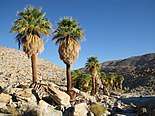 Washingtonia filifera
Washingtonia filifera- Washingtonia robusta
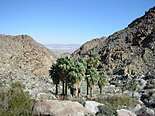 Washingtonia palms near Twentynine Palms, California, USA
Washingtonia palms near Twentynine Palms, California, USA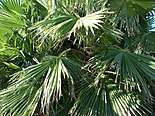 Washingtonia fronds
Washingtonia fronds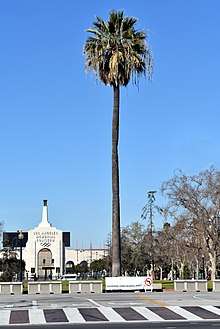 historic fan palm (first known transplanting late 1850s[5]) in Exposition Park, Los Angeles, California, USA
historic fan palm (first known transplanting late 1850s[5]) in Exposition Park, Los Angeles, California, USA
References
- H.A. Wendland, Botanische Zeitung 37:1xi, 68, 148. 1879 (conserved name)
- Kew World Checklist of Selected Plant Families
- Riffle, Robert L. and Craft, Paul (2003) An Encyclopedia of Cultivated Palms. Portland: Timber Press. ISBN 0-88192-558-6 / ISBN 978-0-88192-558-6
- German botanist Hermann Von Wendland designated the name in 1879. http://www.public.asu.edu/~camartin/plants/Plant%20html%20files/washingtonia_filifera.htm
- D.J. Waldie (10 May 2013). "Remembering What's Always Been Here: The Oldest Palm". www.kcet.org/. Retrieved 2019-03-02.
External links
- Flickr: Washingtonias in Russian National Subtropical Garden
- Flora of North America: Washingtonia
- Scanpalm: Washingtonia
- [German botanist Hermann Von Wendland designated the name in 1879. http://www.public.asu.edu/~camartin/plants/Plant%20html%20files/washingtonia_filifera.htm]
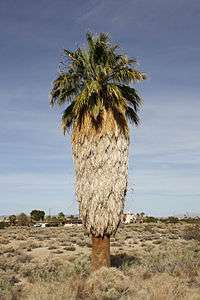
.jpg)